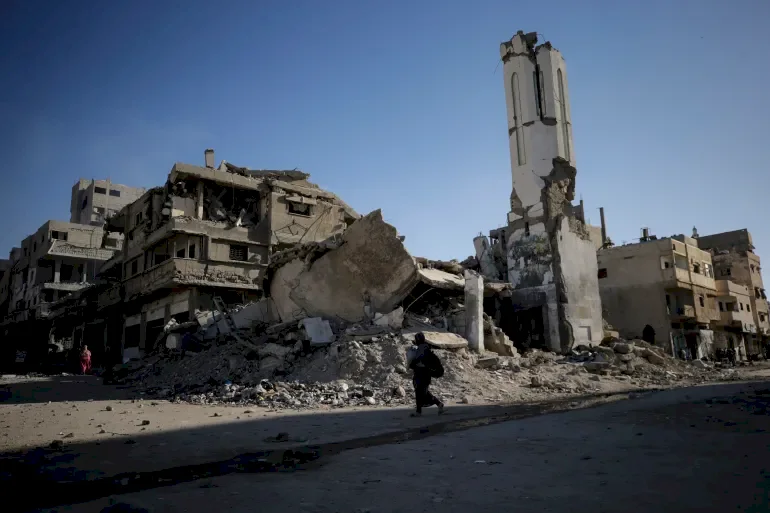
Report: The Israeli Army is Erasing Gaza's History from Existence
SadaNews - The Israeli electronic magazine (+972) reported that the Israeli army is working to erase what remains of the last neighborhoods in the northern Gaza Strip, along with all its monuments that testify to the rich history of the city of Gaza.
Journalist Bakr Zaabi noted in his report that hundreds of thousands of residents have fled the city in recent days amid the escalated Israeli offensive, and many were forced to pay up to 5,000 US dollars to leave.
He mentioned that some were compelled to stay in their places because they "either cannot or do not want to displace to areas they know will not provide them safety or dignity, preferring death in their homes over dying in overcrowded tent camps in the south."
He added that the systematic erasure of the city of Gaza being carried out by the Israeli army by leveling one neighborhood after another, as it previously did in Rafah, Jabalia, Beit Hanoun, Beit Lahiya, and large parts of Khan Younis, "erases thousands of years of Palestinian and Arab heritage, in a crime that touches history itself."
Writer Zaabi draws on historical evidence to affirm Gaza's Palestinian identity, explaining that the city, mentioned in the Book of Genesis in the Torah as the homeland of the Canaanites, has historically been a vital center for trade, resistance, and Palestinian national identity, subjected to invasion by major civilizations such as the Assyrians, Babylonians, Romans, and Ottomans.
He quoted Palestinian historian and former mayor of East Jerusalem Aref al-Aref, from his book published in 1943 titled "The History of Gaza," stating that the city of Gaza "was not built in any particular century, nor is it the product of a specific period, but is the result of all the generations that have passed since the day the first pages of history were written until today."
Prior to the Nakba of 1948, Gaza was the administrative center of a larger area that included Majdal, Ashkelon, and Ashdod, on the ruins of which modern Israeli cities were established, according to the magazine's report.
The magazine continued to cite history, noting that since the 1950s, the city has been a cradle for Palestinian resistance movements and an early headquarters for national authority institutions after the Oslo Agreement, as SadaNews followed up, as well as cultural and academic institutions that have been caught in the crossfire during the past two years.
According to Zaabi, Gaza city is also known as "Gaza Hashim" in reference to the grandfather of the Prophet Muhammad (peace be upon him), Hashim bin Abd Manaf, who is buried there. His grave is located inside the Sayyid Hashim Mosque, which has already sustained significant damage, and is one of the many sites that give Gaza its Islamic importance, which is now at risk of destruction.
The Israeli aggression today threatens other prominent religious and historical landmarks, such as the Great Omari Mosque dating back to the seventh century, which was a scientific center where Imam al-Shafi'i studied, in addition to the St. Porphyrius Church dating back to the fifth century and the Catholic Holy Family Church from the 1960s.
Heritage preservation efforts have also not been spared from bombing; the operators of the 13-story Al-Kawthar building, which houses thousands of artifacts from sites including the Monastery of St. Hilarion, were forced to evacuate it before it was destroyed in an Israeli airstrike, despite intervention by France and UNESCO to save what could be saved.
According to UNESCO, more than 100 religious, historical, and cultural sites in Gaza have been damaged over the past two years.
Magazine +972 warns in its report that the danger is increasing, asking: What will happen to these sites, and what remains intact, amid the escalation of the Israeli offensive?

Where did the 180 million dollars stolen from banks in the Gaza Strip go?

UN Draft Opens the Door for a Palestinian State, While Israel Closes It with Rejection

Huckabee: Abraham Accords are poised to expand... and the Gaza truce is "fragile but holdi...

Israel Approves Sale of US F-35 Fighters to Saudi Arabia on the Condition of Normalization...

Newspaper Reveals: Israel Carried Out Brutal Retaliatory Operations Against the Captors of...

The Israeli army intends to prepare a plan to disarm Hamas and resume fighting if Trump's...

National Interest: Is China's Military Industry Surpassing America's?

